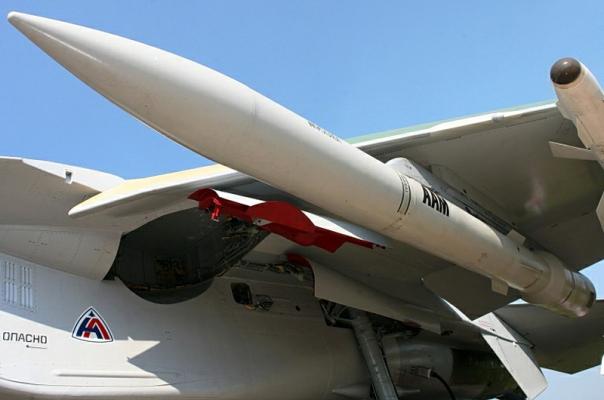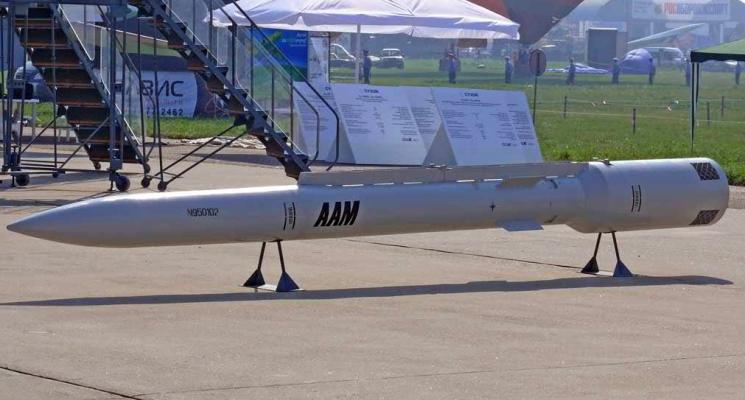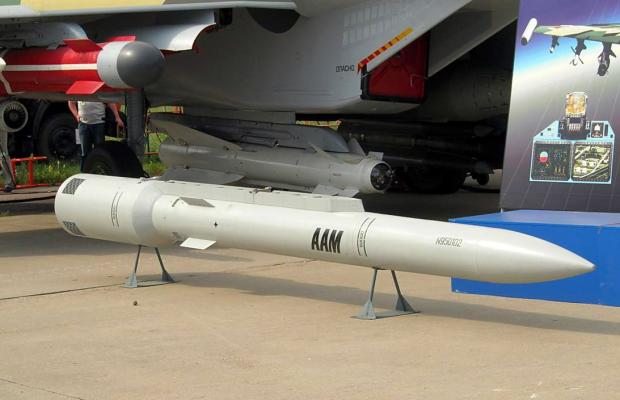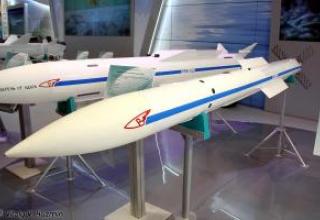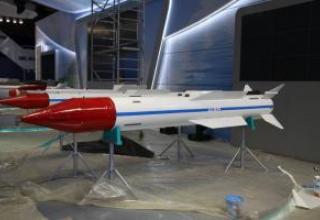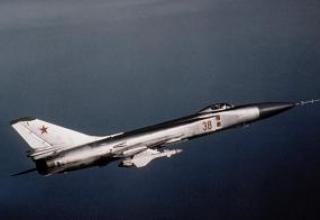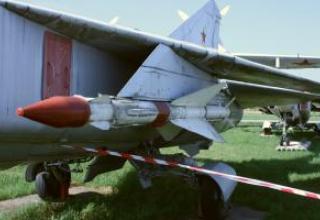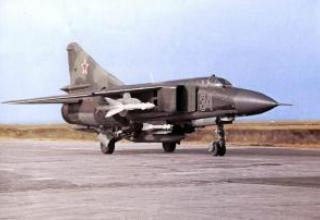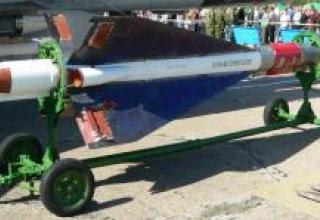KS-172 is a promising Russian short-range air-to-air guided missile designed to fight strategic bombers, DRLO aircraft, air command posts, high-altitude scouts, refueling aircraft and other targets located far from the front line and covered by enemy fighter aircraft.
The main developer is OJSC Novator Design Bureau named after L.V. Lyuliev. (Ekaterinburg).
The development of an ultra-long range aircraft missile was started at the Novator Design Bureau in 1991. The basis was taken as a well-proven missile 9M83 ground complex air defense S-300V. Already in 1993, the model of the missile was first demonstrated at MAKS-1993 (see photo). Funding problems, however, led to the freezing of the programme. Under the conditions of insufficient funding, the Russian Air Force preferred to use the R-37 missile developed before the collapse of the USSR. This was affected by tests in 1994, when R-37 successfully intercepted an air target at a range of 300 km, comparable to that of KS-172. Thus, the Russian Air Force, having in service a large number of interceptors MiG-31, could effectively solve all tasks of protection and control of airspace, and therefore did not have an acute need for more long-range missiles.
India was interested in purchasing these missiles, as well as in arranging their serial licensed production on its territory, which provided a significant share of the project financing. This decision was influenced by the fact that the Indian Air Force's prospective aviation is based on the Su-30MK multifunctional aircraft, which are less high-speed and high-altitude than specialized MiG-31BM interceptors, and therefore require more long-range missiles to provide comparable capability to hit remote targets.
In December 2003, at the exhibition in Dubai, the Novator Design Bureau presented the export version of the KS-172C-1 missile as one of the Su-35 armament types. Later, the missile was also presented at the Moscow International Aviation and Space Salon MAKS-2007 (see photo1, photo2, photo3). The KS-172C-1 missile received a new launch engine and the second stage of a modified configuration, the overall dimensions remaining the same. This modification has a target range of 300 km, which corresponds to the position of the Missile Technology Nonproliferation Control Regime.
At the Air Show China 2008, Russia came out with a proposal to supply a KS-172C-1 missile for the Chinese People's Liberation Army as part of the armament of 38 newest Su-35MKK multifunctional combat aircraft.
At present, KS-172 is the most long-range air-to-air missile in the world, and its range is much greater than that of its closest competitor, R-37.
In the west, it is designated AAM-L (Air-to-Air Missile - Long range).
Composition:
KS-172-1 is a two-stage solid propellant rocket built according to the aerodynamic scheme "bearing body". The rocket is equipped with all-terrain rudders located in the tail of the second stage and stabilizers of the lattice type on the first stage. To reduce the transverse dimension, the stabilizers are made of folding ones.
The first stage is a solid fuel accelerator 3L10, which provides acceleration of the rocket at the initial stage of flight. The length of the first stage is 1400 mm.
The second stage has an active radar homing head (ARGSN) 9B-1103M, inertial guidance system and autopilot. Behind the equipment unit is a fragmentation and high-explosive warhead. The tail unit is equipped with a solid propellant rocket engine and a steering compartment.
The missile is controlled by aerodynamic rudders in the marching section. In this section, the missile is guided by a command-and-control system and the flight is conducted along energy-optimal trajectories, which ensures extremely high achievability.
At a range of 80-100 kilometers, the missile switches to active radar homing, carried out using the ARGSN 9B-1103M (see description).
The ARGSN 9B-1103M provides:
- searching, capturing and escorting air targets,
- receiving and decoding radiocorrection signals,
- generating and transmitting signals over a digital communication line to control the missile.
The combat unit is a shrapnel-fired, directed action. Explosion of a combat unit is provided by a non-contact radar fuse or a contact fuse in case of direct hitting the target.
Suspension of the missile on an aircraft carrier is carried out using an aircraft catapult device AKU-172 (see photo). The AKU-172 was developed by the Start Research and Production Association, OJSC (Ekaterinburg).
Characteristics:
| Maximum launch range, km | 400 (300 for AAM-L) |
| The height of the flight of the targets, m: - minimum - maximum |
3 30000 |
| Average rocket speed, km/h | 1400 |
| Maximum target speed, km/h | 4000 |
| Maximum overload of affected targets | 12 |
| Dimensions, mm: - length - case diameter - first stage diameter - steering wheel range |
7400 400 510 750 |
| Missile launch weight, kg | 750 |
| Weight of combat unit, kg | 50 |
Testing:
29.07.2004 First tests of Arrow-2 system off the coast of California. The anti-missile successfully hit a target simulating a "Scud" missile at an altitude of 40 km.
26.08.2004 Arrow-2 system failed tests off the coast of California. The anti-missile failed to intercept a target fired from an aircraft simulating an advanced Scud-D missile. During the tests, the detection radar successfully detected and identified the target. Problems arose during the final phase of the interceptor flight, after the first stage separation.
On 02.12.2005, the missile defense battery deployed at Palmahim Air Base successfully intercepted a target simulating the operational-tactical missile "Shihab-3". In the tests, an upgraded version of the Arrow-2 block 3 anti-missile was used, which has enhanced tactical and technical data, including for actions against group targets.
11.02.2007 First night launch of the Arrow-2 anti-missile. Two geographically dispersed batteries of the Israeli ABM system were used in the tests. The interception was provided by a battery located at a greater distance from the launch site of a target launched from an Israeli Air Force F-15 fighter.
26.03.2007 Successful testing of the improved Arrow-2 rocket in conjunction with other systems of the complex. New interceptor has modernized control system and longer range.
16.04.2008 Successful launch of the new Arrow-2 block 3 missile modification on the target simulating Shahab-3 ballistic missile launched from F-15 fighter. During the tests in test mode for the first time the improved EL/M-2080S Super Green Pine detection radar was used.
07.04.2009 Successful test of the Arrow-2 block 4 missile. Ankor Cahol (Blue Sparrow) target launched by Israeli Air Force F-15 fighter from a distance of about 1000 km was intercepted over the Mediterranean Sea. The EL/M-2080 Green Pine radar and the American forward-based mobile radar (FBX-T) AN/TPY-2, deployed in the Negev in late 2008, took part in the test.
On 27.07.2010 the USA and Israel concluded an agreement on joint development of a new Arrow-3 missile system. According to the document, Israel will receive $100 million from the United States to work on this BMD system.
On 22.02.2011 the USA and Israel jointly tested the upgraded Arrow-2 anti-missile. The missile was launched on the California coast and was considered successful - the missile hit a ballistic target launched from a U.S. Navy ship. This test was the second one in which the full Arrow BMD system, including the EL/M-2080 Green Pine radar, took part.
29.07.2011 Successful first test of the Arrow-3 anti-missile system. The missile successfully hit the conventional enemy's ballistic target missile.
10.02.2012 Testing of the Arrow-2 block 4 anti-missile, as part of the complex. Detection and tracking of the target launched from an Israeli Air Force fighter was performed for the first time using the EL/M-2080S Super Green Pine radar. After the information was transmitted to the Citron Tree combat control system, an intercept team was formed and no actual missile launch was conducted.
25.02.2013 Israel Defense Ministry announced a successful flight test of the Arrow-3 complex over the Mediterranean Sea. The interceptor reached a flight altitude of 100km, the flight lasted 6 minutes.
03.09.2013 Israel Missile Defense Organization and the U.S. Missile Defense Agency (U.S.) announced the first flight test of a new target "Ankor Shahor" ("Black Sparrow"). The test was conducted at an Israeli test site in the Mediterranean Sea. The targets were launched at 9:15 a.m. The test was conducted at the Israeli test site in the Mediterranean Sea. The radar Super Green Pine of Arrow complex detected the target and provided escort, the information received was transmitted to the combat control system Citron Tree. According to the Israeli Defense Ministry, all elements of the missile defense system worked out as usual.
The Russian Defense Ministry said that the radar station of the Russian missile warning system, located in Armavir, detected the launch of two ballistic missiles from the Mediterranean Sea towards Syria. According to the Russian side, both objects fell into the sea.
09.09.2014 Testing of the Arrow-2 ABM system to intercept the Ankor Shahor target (see photo). Interception failed.
03.01.2014 According to the press-service of the Ministry of Defence, the second test of the Arrow-3 ABM system took place at the Palmakhim airbase. At 08:00, the Arrow-3 missile interceptor successfully entered the calculated flight path in the upper atmosphere, in accordance with the test plan. All systems worked out in the normal mode.
09.09.2014 The Israel Defense Ministry announced that the advanced Arrow-2 ABM system had been tested. The purpose of the tests, conducted with the assistance of the Pentagon, was to test the effectiveness of the new version of the system against future potential threats. Later on the Israeli media published information that the tests failed.
16.12.2014 Failed tests of the Arrow-3 anti-missile. The Israeli Defense Ministry reports that problems occurred during the launch of the missile.
10.12.2015 The Israel Defense Ministry reported the successful test of the Arrow-3 BMD system (see photo). The interceptor missile was launched at 8:10 local time and successfully intercepted the target outside the atmosphere. It was launched from the Palmachim military base at the Anchor Shahor target fired by an Air Force aircraft over the Mediterranean Sea.
